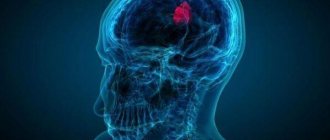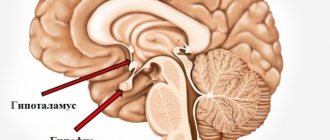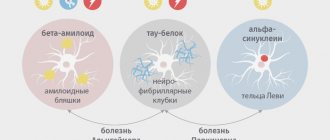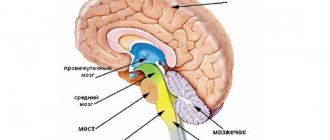What is the pineal gland?
The content of the article
The pineal gland is a small organ located in the brain. It is similar in size to a grain of rice (5 to 8 mm) and its name comes from its cone-like shape.
Pineal gland
Despite its location, the pineal gland is not covered by the blood-brain barrier and its rich blood supply is similar to that of the kidneys. It is noteworthy that her complete education takes place between the ages of 1 and 2 years. After this time, the organ stops developing. Its mass increases only after puberty.
The pineal gland consists of several groups of cells divided into so-called lobules. Connective tissue septa separate individual lobules from each other.
The pineal gland consists of:
- Pinacocytes, or pineal gland cells, contain pleomorphic cell nuclei consisting of smaller nuclei;
- Glial cells with a network of glial fibrils - these cells, together with nerve cells, form the nervous system and constitute a layer of insulating cells;
- Nerve cells with nerve fibers - nerve fibers come from neighboring parts of the brain;
- Brain sand - this part consists of round and slightly yellow cells. In addition, it contains calcium phosphates and carbonates.
In ancient times, philosophers emphasized that the pineal gland is the place where the soul influences the body. It is often called the most mysterious organ of the human body, because it is it that has the greatest influence on the human psyche.
This single, odd element of the brain, located exactly in its center, is very often called the “third eye.”
Clinical manifestations and consequences of epiphysis cysts.
The main danger of a pineal cyst is that the symptoms of this disease appear quite late, when the tumor reaches a fairly large size (about half of the pineal gland). At the same time, almost all symptoms are nonspecific (that is, characteristic of many diseases), which greatly complicates the diagnosis of the disease. The severity of clinical symptoms depends on which neighboring parts of the brain the cyst presses on and how much it blocks the movement of cerebrospinal fluid (this is possible when the cyst is more than 5-10 mm in diameter).
The main manifestations of an epiphysis cyst:
- recurrent headache for no apparent reason
- double vision, blurred vision
- nausea and vomiting
- impaired spatial orientation, coordination, unsteadiness of gait
- disorders of the cardiovascular system
- asthenovegetative syndrome (increased fatigue, drowsiness)
Separately, it should be noted a number of features that a cyst of parasitic origin has. During its life, echinococcus produces a number of substances that are toxic to our body. They cause the appearance of a number of additional symptoms:
- Impaired motor function of the nervous system (paresis, paralysis)
- disturbance of the sensitive function of the nervous system (hypoesthesia, anesthesia, paresthesia) - pain, tactile, temperature sensitivity can be upset, both individually and together
- epileptic seizures
- depression
- disorders of neuropsychic development in children
Based on these symptoms, it is quite difficult to suspect a pineal cyst. It may be noted that some manifestations of the disease, such as headache, are not controlled by conventional medications (such as non-steroidal anti-inflammatory drugs, antihypertensive drugs). Only a more in-depth study can give an unambiguous interpretation to the above symptoms.
What are the functions of the pineal gland?
The pineal gland is an endocrine gland. This means that the hormones it produces enter the bloodstream. Thus, the gland regulates the functioning of certain tissues and organs.
Located at the back of the diencephalon, the gland connects to the telencephalon, which is responsible for most mental processes.
The main task of the pineal gland is primarily the production of melatonin. This hormone has many functions in the central nervous system, the most important of which is responsible for the circadian cycle. When exposed to light, melatonin synthesis is suppressed, and when we are in the dark, melatonin synthesis increases - this affects the rhythm of sleep and wakefulness.
Melatonin production
In addition, the pineal gland is responsible for the release of growth hormone, thyroid-stimulating hormone, which is responsible for regulating the thyroid gland, and adrenocorticotropic hormone, which regulates the adrenal cortex.
In addition, the pineal gland is responsible for the release of sex hormones that regulate the maturation process.
The most important functions of the pineal gland include:
- regulation of blood pressure;
- coordination of the central nervous system;
- regulation of the human circadian system through the production and secretion of melatonin and serotonin;
- informing the body about the need to go to bed, causing a feeling of drowsiness;
- informing the body about its readiness to engage in everyday activities;
- release of certain groups of growth hormones; TSH; ACTH;
- influence on the level of melanin (skin pigment) through melatonin;
- responsibility for autumn and winter depressions;
- maintaining the body's ability to fight cancer cells;
- strengthening the immune system;
- influence on metabolic changes;
- strengthening bones (decreased pineal hormone levels significantly weaken bones);
- slowing down the aging process by regulating sleep.
The pineal gland also produces substances that are largely responsible for the feeling of euphoria. Scientists believe that it is also responsible for hallucinatory states. But most importantly, the hormones secreted by the pineal gland give a person joy and a sense of satisfaction, and also reduce depressive mood, which is a very important element of everyday life.
Pineal hormones
Pineal hormones have a very strong influence and regulate the lifestyle of every person. An analysis of the functions of the individual hormones secreted by this gland in everyday life provides convincing support for the assertion that the pineal gland is the place where the soul interacts with the body, and the body with the soul. What hormones does this “secret” gland secrete?
The two most important hormones produced directly by the pineal gland are:
- Serotonin
– this hormone is released throughout the day. First of all, it has a calming effect, but too low its level causes depression, anger and even aggression. Serotonin additionally provides a signal to prepare for sleep. - Melatonin
– produced by the pineal gland at night. It makes people feel sleepy. But the light that reaches melatonin definitely lowers its levels. So, this is the information that you need to get up after the night. - DMT (dimethyltryptamine)
– this hormone is produced by the cells of the pineal gland. It is a type of psychedelic psychoactive substance. May cause hallucinations and strong visual effects.
By producing these hormones, the pineal gland is entirely responsible for regulating each person's circadian system. The effect of the hormones of this gland is most strongly felt when changing time zones (the famous “jet lag syndrome”). Their deficiency additionally causes appetite or metabolic disorders.
Jet lag syndrome
The pineal gland not only produces its own hormones, but also participates in the production of others. These include:
- Vasopressin
– stimulates growth levels. It also regulates the density of urine. The largest amount of this hormone is produced during sleep. Vasopressin also stimulates the production of cortisol, and the pineal gland secretes this hormone from the pituitary gland. - Somatropin
is the name of growth hormone. The pineal gland is involved in its production, and the highest levels of this hormone occur during puberty. - Thyroid hormones
- the small pineal gland secretes melatonin and also regulates the thyroid gland by stimulating thyroid-stimulating hormone (TSH). - Gonadotropins
- these hormones stimulate the activity of the human gonads (ovaries and testes). The pineal gland plays a very important role in the process of puberty and supports the functioning of these organs, - ACTH
, also known as the stress hormone, the pineal gland is involved in the production of this hormone. As a result of its action, more cortisol is released, and the pineal gland regulates this process. Thanks to these actions, the body properly prepares for awakening.
What is the gland responsible for?
The epiphysis or pineal gland or pineal gland is the name of the structure in the human brain located in the quadrigeminal zone, that is, on the upper wall of the midbrain.
This is a gland of the diffuse endocrine system, which forms a dispersed network of excretory cells in the body.
The pineal gland is still poorly studied; it performs a number of functions in the body that are directly responsible for consciousness and thinking.
The structure of the epiphysis consists of lobules formed by a connective tissue capsule. Located in the head, the pineal gland is located outside the blood-brain barrier. This leads to the fact that it is easier to influence the gland biochemically.
It has now been confirmed that the pineal gland, directly or indirectly, produces the following effects:
- inhibits the production of somatotropin;
- enhances the effect of anti-cancer mechanisms;
- inhibits the processes of puberty and selectively inhibits sexual desire (libido);
- but, despite the possible inhibitory effect, the pineal gland is rather a regulator of sexual behavior.
The pineal gland itself produces the following hormones:
| Hormone name | Description |
| Melatonin | One of the main regulators of the circadian rhythm controls sleep and wakefulness. Twilight and darkness lead to increased production of the hormone, which penetrates into the blood, saliva, urine, amniotic and cerebrospinal fluid. A large number of receptors for this hormone are located on the membranes of the cells of the anterior pituitary gland. |
| Serotonin | Melatonin in the pineal gland is synthesized biochemically from serotonin. Serotonin itself is the most important neurotransmitter responsible for positive emotions and cognitive functions. |
| Adrenoglomerulotropin | This hormone is a derivative of melatonin. It may have psychoactive properties. Aldosterone is a regulator of water-salt balance (retains sodium, removes potassium), which means adrenoglomerulotropin indirectly too. |
| Dimethyltryptamine | The hormone is produced during REM sleep. The substance has pronounced psychedelic properties. Dimethyltryptamine is a type of serotonin receptor agonist. Due to its chemical similarity to serotonin, dimethyltryptamine may have similar psychological effects. |
The peculiarity of the structure of the pineal gland, which is divided into two hemispheres (visible during microscopic examination), still raises questions. In fact, it is a mini-model of the brain.
Melatonin, the most important hormone produced by the pineal gland
Melatonin, synthesized by the pineal gland, acts as a “signpost” to our biological clock. The cycle in which it is secreted by the pineal gland affects sleep at night. Its proper release is very important for health. However, with today's lifestyle, this rhythm is very easy to disrupt.
So-called “night breaks” or night shifts lead to a decrease in the release of this hormone from the pineal gland. Not only does this lead to later problems falling asleep, but it can also increase your risk of diabetes, prostate and breast cancer.
As we age, the activity of the pineal gland decreases, which can lead to problems falling asleep in older people. Therefore, for insomnia, medications containing melatonin are recommended. However, it should be remembered that medications with melatonin should be used only after prior consultation with an endocrinologist.
Pineal gland diseases
The main disease that can affect the pineal gland is a tumor of the pineal gland. When tumors (or cysts) appear, most often, but not always, the activity of this organ is completely suppressed.
The most common symptoms of a pineal tumor are:
- dizziness and headaches;
- vomiting, nausea;
- impaired vision and balance;
- loss of consciousness.
Dizziness
In young people, tumors on the pineal gland can cause premature puberty.
Magnetic resonance imaging is performed to detect changes in the pineal gland. And surgery is required to remove them.
Diagnostics
A neoplasm can be discovered completely by accident, when a person undergoes a routine examination. But, if a patient turns to a therapist or neurologist with complaints of incessant headaches, the doctor recommends taking tests and undergoing examinations:
- General blood and urine analysis.
- Blood for sugar and cholesterol.
- Doppler of the vessels of the neck and brain.
- MRI (magnetic resonance imaging) and CT (computed tomography) of the brain and neck.
It is on MRI that a cyst is most often detected in the pineal gland of the brain. If the patient has no complaints, his condition is unchanged, the doctor does not prescribe therapeutic measures. The cyst is simply observed: the patient undergoes an MRI and tests every six months.
If there is a suspicion that not a cyst, but a cancerous tumor is developing in the lobes of the pineal gland, doctors recommend taking a biopsy. The procedure involves collecting tissue and fluid from the cystic formation and examining the material in the laboratory.
Pineal cyst
A pineal cyst is quite often diagnosed as a disease.
A pineal cyst is a very benign tumor lesion that does not spread to other organs. This cyst is filled with inflammatory cells (leukocytes, lymphocytes and macrophages). Usually surrounded by delicate epithelium. It is difficult to identify clear reasons for its formation. Most often it occurs in young people when the pineal gland undergoes many transformations. This causes some changes in the organ.
A pineal cyst is asymptomatic, but when it puts too much pressure on the brain structures, the following symptoms may appear:
- long-term migraines (up to 72 hours);
- problems with proper vision, squint;
- sleep disturbance;
- disturbances of wakefulness.
Prolonged migraine
This disease is very often detected only by computed tomography or magnetic resonance imaging, carried out in the diagnosis of other diseases. Treatment for pineal cysts mainly involves eliminating symptoms and pain. This condition should be regularly monitored by a doctor. Very often the cyst resolves or significantly decreases in size, but if the lesion grows, surgical intervention is required.
Manifestations of pineal gland cysts
The symptoms of an epiphysis cyst depend on its size and growth rate, however, the overwhelming majority of true cystic formations of the organ do not have specific manifestations or they are so weak and “blurred” that they do not make either the owner of the cyst or specialists think about pathology.
Symptoms of an epiphysis cyst appear when its size exceeds 1 cm. As a rule, this applies specifically to parasitic cavities that can quickly increase to a significant diameter, while retention cavities that appear due to a violation of the outflow of secretions are unlikely to produce any -symptoms due to small size.
Among the signs that may indirectly indicate the presence of an epiphysis cyst are:
- Headaches that appear for no apparent reason, which are difficult to associate with increased blood pressure, stress or fatigue;
- Nausea and vomiting accompanied by intense pain in the head;
- Pain when turning the eyeballs upward;
- Visual disorders;
- Poor orientation in space, coordination of movements;
- Drowsiness and difficulty falling asleep, in severe cases - lethargy.
Symptoms of a pineal gland cyst are associated, first of all, not with a violation of its secretory function, but with the fact of compression of the surrounding nervous tissue, which occurs with large sizes of the formation. The pineal gland is located deep and tightly surrounded by other brain structures, so even 1 cm above the normal volume of the organ in the midbrain region can already provoke negative manifestations.
Headache with nausea and vomiting is often caused by concomitant hydrocephalus due to obstruction of the cerebrospinal fluid pathway. An increase in intracranial pressure is also accompanied by pain in the eyeballs, loss of consciousness and convulsions are possible. Analgesics do not bring relief to such patients; the pain is compressive and persistent.
Visual disturbances are caused by compression of the optic chiasm and nerve fibers running from the eyes to the centers of the posterior part of the brain. They consist of a decrease in visual acuity, the appearance of a veil before the eyes, and double vision.
A parasitic cyst, in addition to headaches and hydrocephalus, tends to cause convulsions and mental disorders, including severe psychosis and dementia, and compression of the centers of the medulla oblongata due to increased intracranial pressure and brain dislocation is fraught with the death of the patient.
Severe neurological disorders in connection with echinococcosis of the pineal gland are caused not only by the presence of a cavity compressing the brain, but also by perifocal inflammation and hemorrhages into the nervous tissue, so the prognosis for such a disease will be very serious.
A long-existing large cyst of the pineal gland threatens chronic hydrocephalus with gradual atrophic processes in the brain, which can result in a decrease in intelligence, memory and attention, resulting in severe dementia. Parasitic cysts are dangerous due to dislocation of the medulla oblongata, severe convulsions, and acute occlusive hydrocephalus.
Small cysts do not pose any harm to the life or health of their carrier, since they do not affect the secretory activity of the gland and neighboring brain formations, but are subject to dynamic monitoring due to the risk of increasing in volume.
Some women with cystic transformation of the pineal gland experience difficulties in becoming pregnant; there may be a lack of ovulation and menstrual irregularities. A clear connection between infertility and an existing cyst is usually not observed, although it is very difficult to exclude such a possibility. Treatment with hormonal drugs can provoke an enlargement of the cyst, which should be kept in mind and repeated MRI examinations should be prescribed to monitor the growth of the formation.
Calcification of the pineal gland
Calcification of the pineal gland means the appearance of calcifications on the pineal gland. The pineal gland is quite a strong magnet for fluoride and other harmful elements such as phosphorus and mercury. Excess fluorine and phosphorus disrupts the mineral balance of the body.
Over time, a rather hard limestone crust forms around the gland, which in some sense limits the normal functioning of the organ. The more fluoride deposits there are on the pineal gland, the more severe the calcification.
Symptoms of calcification include:
- severe nausea, vomiting;
- frequent headaches;
- problems with raising the eyeballs.
People with pineal calcification tend to be pessimistic.
Proper diet plays a huge role in cleansing the pineal gland. You need to eat plenty of vegetables and fruits, avoid alcohol and smoking, and avoid fluoride.
Eating plenty of vegetables and fruits
This type of calcification can cause many diseases such as dementia, Alzheimer's disease, Parkinson's disease and multiple sclerosis.
Prevention of pineal gland diseases
There is currently no proven way to protect yourself from a possible pineal tumor. However, this does not mean that we cannot take steps to help the pineal gland function properly. First of all, you should start with a routine - you can’t sit for a long time at night. Adjusting your routine will help you get the right concentration of melatonin, which will help you fall asleep normally.
Additionally, as with any other organ, it is important to follow a proper diet and avoid all types of toxins, including alcohol.
Another important point in the prevention of pineal gland diseases is taking special medications with magnesium and vitamins. All this should be prescribed by an endocrinologist.
ONLINE REGISTRATION at the DIANA clinic
You can sign up by calling the toll-free phone number 8-800-707-15-60 or filling out the contact form. In this case, we will contact you ourselves.
If you find an error, please select a piece of text and press Ctrl+Enter











